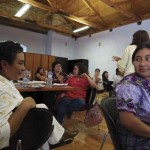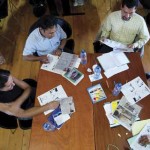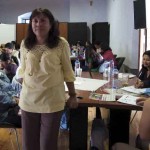Teaching to Think
- Learning can be fun and interactive as participants in the RWCT workshop find out.
- Using cartoons and clippings from current events, teachers practice making learning more interesting and enriching in their classrooms.
- A passionate teacher, Patty Rosales brings the strategies of critical thinking to the Antigua community.
whitten by Christine K. Wilson photos: Santiago Albert Pons
Socrates once said “I cannot teach anybody anything, I can only make them think.” Teaching someone how to think instead of what to think is the hallmark of a good education. A student who thinks is capable of analyzing, of making decisions, and forming opinions—skills badly needed in today’s world. Fortunately for La Antigua, several teachers are following Socrates’ path. They are among more than 40 teachers from 13 public schools and organizations who have completed the workshop. “Reading and Writing for Critical Thinking” (RWCT) recently held at the Cooperación Española.
The workshops, held monthly for six months, provide teachers with strategies on how to help students incorporate logic to read carefully, discuss analytically and write clearly. Using this method, the children are first asked to consider their assumptions on a certain subject, then to research it thoroughly and finally to reflect on what they have learned and how to apply it. These extra steps go beyond the typical read-and-memorize approach used in most local schools. As Patty Rosales, workshop trainer explains, integrating the RWCT strategies “is the beginning of a deeper and more analytical learning.”
On a recent day, the laughs can be heard down the entire length of the corridors of the Cooperación Española. At the RWCT workshop, teachers are presenting a cartoon of their own creation to illustrate what they have read. The cartoon provides more than just a good laugh, it is a way to summarize and express opinions. Strategies like incorporating cartoons, games and current events in the classroom are some of the methods that teachers use to help their students take ownership of their learning. As Elix Estrada, from the Familia de Esperanza project, points out, “When I integrate activities in the classroom, the children not only enjoy it more but also learn more.”
The RWCT was developed by several leading American universities and is now used in more than 30 countries. In Guatemala, the RWCT program was initiated by the Consejo de Lectura or reading council. Experience has shown that the benefits of RWCT go beyond the classroom to help children become better citizens. As Mrs. Rosales explains, “Developing critical thinking in students is the key to fomenting positive change in Guatemala.” Mrs. Rosales would like to see more workshops take place to create a ripple effect on the country.
But as Olga Pérez de Girón, director of the San Cristóbal El Bajo grammar school, says: “We come here to better ourselves, but we could never afford to pay for this level of training.” Lack of government funds for training is a common problem. That is why this RWCT workshop is sponsored by Empresarios por la Educación, Entrepreneurs for Education. Empresarios por la Educación is a non-profit organization whose mission is to utilize the skills, energy and resources of the private sector for the good of public education.
Empresarios has recently established a chapter in Antigua and is developing several projects to improve the area’s schools in addition to the RWCT workshops. For example, Empresarios will coordinate English-speaking volunteers to help public school English teachers to improve their pronunciation, vocabulary and grammar. Over time, this and other projects will help develop a nation of thinkers who can build a better future for Guatemala.
Empresarios por la Educación: www.empresariosporlaeducacion.org
Reading and Writing for Critical Thinking: www.ct-net.net


